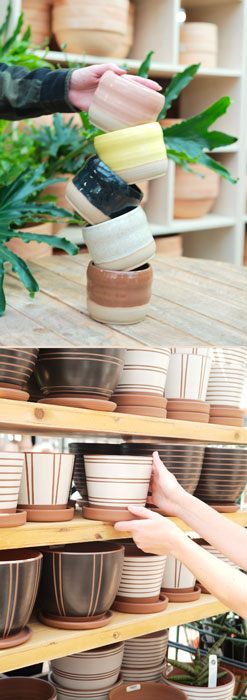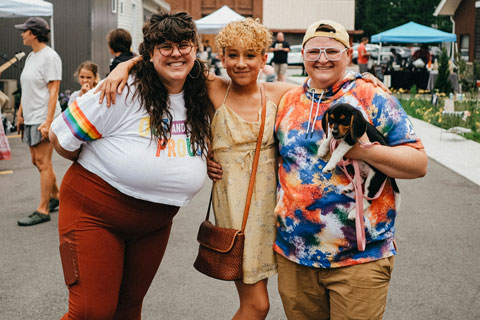4/1/2023
Making Room for Local Makers
Katie Elzer-Peters

One way to ensure your business is part of the greater ecosystem of your community is to work with local makers and artisans. As with any new venture the outline for how to begin, knock it out of the park and grow the program writes itself. It’s what’s between the headings that counts.
I talked with Jessie Jacobson, owner of Tonkadale Greenhouse; Benjamin Futa, owner of The Botany Shop; and Liz Hughes, co-owner of Groovy Plants Ranch, to see how they successfully work with local makers. I also spoke to Jenn Constable, maker and owner of JEMS of the Sea, for the maker perspective. Here’s how they make it work.
Get Clear on Goals
For the best results with local makers, get clear on why you want to include them as part of your business and what you hope the end result will be for both parties.
Do you want to:
• Grow your audience?
• Foster a sense of community?
• Offer opportunities to local businesses?
• Provide new and exclusive choices for your customers?
• Drive business during slower periods?
• Try new product lines before making a substantial investment?
• Differentiate your business from others in your category?
Pictured Top: Top: Handmade pots from Sandwich Ceramics, a Minneapolis-based studio started by Francis Pineda-Fischer, and sold at Tonkadale Greenhouse in Minnetonka, Minnesota.
Bottom: Handmade pots by Brett Monahan and sold at Tonkadale Greenhouse in Minnetonka, Minnesota.
Most local maker initiatives will hit more than one of the goals, but some are far more specific. For instance, if your goal is truly to try a new product line before making a substantial investment, you’re going to need to bring it in on consignment or as a small wholesale order rather than inviting someone in to host a trunk show. That’s because the conditions surrounding a trunk show (Trunk show: The maker is there, talking to customers and hand-selling it) are vastly different from putting an item on a shelf and expecting it to sell itself.
Ben from Botany said two things. One, “always ask the makers what their vision of success is.” Second, he said, “We always tell the vendors if our ultimate goal is to move to a traditional wholesale relationship so that everyone is aligned from the beginning.”
It’s also possible that you start with a goal, say, “Foster a sense of community,” and an initiative, “Bring in artisan goods on consignment or wholesale,” and find that the goal and the initiative don’t match for your business. Groovy Plants Ranch has one space for a bit of non-plant retail: the historic schoolhouse building.
Liz from Groovy Plants said, “We have found that the price point for artisan goods has been higher than the consumer wants to spend, especially given the nature of the gift space.”
To keep working with local artisans, Groovy Plants pivoted and started the “Handmade Hoedown,” an artisan craft fair event in August, which is typically a pretty slow time.
“Last summer was our first one,” said Liz. “And, in addition to the artisans having a great time, it was our highest register sales day in August.”
Choose One & Knock it Out of the Park
Here are some widely adopted and successful ways that garden centers and plant shops are working with local makers:
Trunk show: Invite the maker to bring an extensive selection of their merchandise and hang out onsite for an evening, a day or a weekend.
Ben said, “We’ve had success with trunk shows when we layer them in at times we know we’ll have naturally good foot traffic. Don’t do this on a Tuesday.”
Botany provides a space and a table and the makers make and manage their own sales.
Special event/market: Where I live in Wilmington, North Carolina, pop-ups and markets have sprouted like weeds. Jenn noted, “It seems like there’s one every other day and multiple every weekend all year. Vendors are becoming more choosy about which ones they attend.”
Groovy Plants, Tonkadale and Botany have all dipped their toes in the special event market world this year and had great results. It’s possible that their vendor happiness and customer turnout is related to the limited nature of the event.
“People respond well to novelty and newness,” said Jessie from Tonkadale. A one- or two-day event creates a sense of urgency and intrigue that a monthly market doesn’t.
Wholesale purchase: Jessie mentioned bringing in smaller quantities of local goods on wholesale even if they don’t end up constantly restocking from the same vendor. “Anything that is local, new and fresh will bring people into the store, especially followers of the local artist that might not have been in before. Connecting with the local art community is huge for us.”
From the maker standpoint, “Wholesale is the best case scenario,” Jenn said. “Makers are looking for payments of 50% of MSRP and half down if it is a custom order. Few smaller makers can handle net 30 terms.”
Exclusive collection/product development: Tonkadale has a robust local pottery program. We’ve touched on that before in Green Profit. A few key tips from Jessie: Work with the potters on the sizes of pots to make sure grower pots can drop in easily. When it comes to finding local potters, Jessie said to look on Instagram for local maker and local potter hashtags. “Ceramics” is a good search term, too.
Ben and the Botany crew have had great success offering an exclusive, bespoke candle fragrance. “We sold out in three days. We then ordered two dozen more and sold out. Now we’re taking pre-orders.”
Lead time is essential for custom orders. “I need at least 10 days,” said Jenn. A potter might need up to three months. Planning and flexibility are key, Jessie said. “If a maker has an unexpected life event, your order might be delayed past the season you’d planned for. Then you have to decide if you’re going to merchandise it with the next season or hold it for the following year.”
Consignment: This is the relationship of last resort, for makers and businesses. Consignment takes so much paperwork, energy and tracking that if you’re not doing it on a large scale with a robust system, it’s not usually a win-win.
Communicate Clearly and Thoroughly
This is important for both parties. Some makers are making as a side hustle, while others are full time. Some businesses are new to working with local makers. And while Jenn didn’t say this to me, after talking with her, I’d say to talk with your local makers. Most of them, especially the pros, are experienced working with local businesses and they may have some tips for you. Ben noted they’ve hired an event coordinator to manage makers and events.
Liz said, “You need to have someone wholly dedicated to working with vendors to help direct traffic, show them where their booth location is and circulate during the day. Make them a map and be very clear about when they can set up and when they can tear down.”

Be a Partner
The key point here is to promote your local maker’s involvement, whether it’s a trunk show, a market or a big wholesale order. Jenn said, “It’s a great synergy. You promote us, we promote you and we both get new customers!”
Liz makes sure to provide makers with the marketing collateral for the event at least six to eight weeks in advance so they have easy resources to promote.
Pictured: Attendees from a recent trunk show at The Botany Shop in South Bend, Indiana. Photo Credit: Emily Sexton.
Evaluate and Refine
The first time you do anything it might be rocky. That doesn’t mean you have to quit! You might just need to refine.
When it comes to refining, Liz has experience. She said they still carry some local goods at Groovy Plants, but mostly items that are made by their staff members.
“We’ve found that things sell better when the person that made them is working onsite,” said Liz. “We used to have pottery from a local maker that also worked on staff. Once she left, it stopped selling.”
Ben said a big change they’re making in Botany’s local maker relationships is “we are onboarding them as a cohort so we can go through paperwork, processes and planning with them as a group, instead of one by one.
“We’re in year two and developing systems. Everything works better with systems.”
I heartily agree! GP
Katie Elzer-Peters is the owner of The Garden of Words, LLC, a green-industry digital marketing agency. Contact her at Katie@thegardenofwords.com.